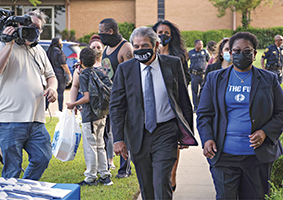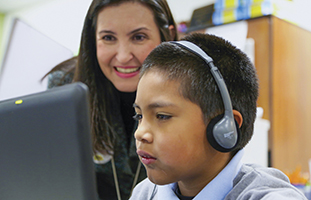
‘They Don’t Just Stop at the Border’
The special challenge of educating non-English-speaking immigrants in the midst of a long-running public health crisis
BY KIMBERLY REEVES/School Administrator, November 2021

|
Michael Hinojosa, superintendent in Dallas, hopes
to lure absent students back to class with modified schedules, prom incentives and additional tutoring. PHOTO COURTESY OF DALLAS INDEPENDENT SCHOOL DISTRICT |
Finding the strategies to get English learners back on the school district’s 230 campuses this fall — after a year when thousands of students never set foot in a school — will mean the difference between failure and success in the Dallas Independent School District this year, says superintendent Michael Hinojosa.
Hinojosa, a product of Dallas schools, knows he’s going to have to find even more strategies to thread the needle to get his first-generation immigrant students and their families back to school. This year, 92 percent of the enrollment in Dallas schools will be Hispanic or Black. Almost half will come to school with limited English language skills.
“Forty-seven percent of our students are English language learners, which means we have around 70,000 ELL students,” Hinojosa says. “We have more English learners than San Antonio has students, than El Paso has students, than Frisco (Texas) has students, than San Francisco has students. So if we don’t do well with this student population, we’re not going to do well as a district.”
Escalating Growth
Trends in Dallas are mirrored on the national level. The latest national statistics from the National Center for Education Statistics, updated in May, show the number of English learners has grown from 4.5 million in 2010 to 5 million in 2018, with most of the growth in a handful of states. Statistically, most English learners will speak Spanish, enroll in the early grades on urban campuses and come from working-class families where both parents have earned the equivalent of a high school diploma or less.
In Dallas, the number of English learners — not just Hispanic students, but students who come to the campus with limited English skills — has outpaced other student groups. That’s because of the massive growth of charter school enrollment in Texas, Hinojosa says. During his first stint as superintendent, between 2005 and 2011, about 10,000 students had left for public charter schools. To-day, that number is 40,000.
The racial balance of the school district has remained the same, but the percentage of English language learners has jumped from 35 percent to 47 percent of all DISD students. That’s because Dallas has become a magnet for immigrant families seeking a stable life.
“They come to Dallas for the jobs. They don’t just stop at the border,” Hinojosa says. “There are jobs in the service industry here and plenty of chances for gainful employment.”
An Evolving Course
The concept of bilingual education is not new. Only the language and the methods have changed. Ohio passed the first bilingual education law in 1839, at the request of German farmers. Students in Louisiana were taught in French. In New Mexico, the language was Spanish.
After World War I, most states moved to an English-only immersion model in a misguided attempt to “Americanize” students. The federal government passed the Bilingual Education Act in 1968, a concept that was affirmed by the U.S. Supreme Court in 1974 in Lau v Nichols, a case in which Chinese-speaking families forced the San Francisco Unified School District “to provide adequate instruction-al procedures” under the Civil Rights Act.
A record surge in immigration in the 1970s, however, led to national pushback on the use of bilingual education, which allows a teacher to instruct students in their native language. By 2000, the National Education Association estimated 40 states had laws on the books that limited the use of the bilingual instruction model. Three states — California, Arizona and Massachusetts — passed outright bans on the use of bilingual instruction, forcing school districts to rely on less effective models: English as a second language or structured English immersion.
That tide is slowly turning. California and Massachusetts have overturned their English-only models. In 2019, Arizona loosened its grip on the required four-hour blocks of English immersion instruction, giving school districts some flexibility in instructional methods. Samuel Ortiz, a psychology professor at St. John’s University whose research focuses on assessing children who are linguistically different, says the English-only model has failed children.
“When you compare data on Arizona, which is still English only, and you compare it to states like Texas or Florida or even New York, where bilingual education is still common, you’ll see a great disparity in terms of educational outcomes of those English learners, just because of where they live,” Ortiz says. “That’s because some states have a stronger commitment to providing native language instruction, which is effective and is what is required to be able to give kids half a chance.”
Districts must recognize that the English learner comes into the classroom with a five-year deficit in English cognition, Ortiz says. The early years are critical. New efforts to implement dual-language instruction — and even two-way dual-language instruction — is far more effective. He urges school districts to make a commitment to literacy in two languages.
“The problem is that people aren’t patient,” Ortiz says. “The students don’t show the best gains in English language arts or on their state-run math tests up until the sixth grade. “They’re lower than average, but once they level up on their language skills, they actually continue to increase in achievement. The bilingual students end up ranking about 20 percent higher than the average monolingual kid.”
The federal government also has added incentives for “leveling up” English learners. The Every Student Succeeds Act, passed in 2015, pulled English learners out of Title III funds and added them to Title I programs. That means not only districts but also individual campuses are funded to make progress with English learners across the entire curriculum.
Dual Approaches
School districts entered this school year faced with both attendance and academic gaps for students. Groups that provide profession-al development for schools with a high percentage of English language learners, such as the Intercultural Development Research Association in San Antonio, are urging educators to recognize some key factors shaping the new school year: Absenteeism among students overall has doubled. Morale is down.
Hector Bojorquez, IDRA’s director of operations and educational practice, hosted a recent webinar for schools, urging them to employ multi-subject thematic units, project-based learning and cross-age tutoring. Giving students, even struggling students, a teaching role often builds their confidence. Students will rise to the occasion, he says.
“I’m not saying that there has not been learning gaps that have occurred,” Bojorquez adds. “I’m saying that the approach to those learning gaps has to be different. It cannot be the same thing that we’ve tried over the years. When students have agency, they can be the greatest advocates for their education.”
Libia Gil has served as the chief education officer for the Illinois State Board of Education and as an assistant director in the Office of English Language Acquisition at the Department of Education. During her tenure as a superintendent of a highly diverse district in southern California, she encouraged and supported the creation of multiple adult English as a second language programs.
“Many principals taught their own ESL classes for parents right after the parents dropped off their children,” Gil says. “We also provided ESL classes at community centers and worked with apartment complexes to offer similar opportunities, with free child care.”
Her district’s support stretched across a continuum, from English only to English as a second language to transitional bilingual and, eventually, dual language. Dual language has become the gold standard because it creates language literacy in the first and second languages.
Personal Connections
Superintendents whose schools find success with immigrant students — especially those families who may be undocumented — say personal relationships serve as the launching pad.
 |
| Lupita Hightower, superintendent of Tolleson Elementary School District in Phoenix, Ariz., is challenged by state law restricting dual-language instruction. PHOTO COURTESY OF TOLLESON ELEMENTARY SCHOOL DISTRICT |
Lupita Hightower, superintendent of the 2,800-student Tolleson Elementary School District 17 in Phoenix, Ariz., faces the challenge of educating English language learners in a state that has discouraged bilingual education in the classroom. She says being visible and developing a direct relationship with her students — she visits all four of the K-8 campuses two or three times in a typical week — builds a level of trust with her families.
“That’s one of the things that the families have shared,” says Hightower, a Spanish speaker. “They like a school district where you can just go and talk to the superintendent in your own language. The families appreciate that. And our board is huge on providing the best customer service.”
One major reason for that is because school choice prevails in Phoenix, which has around 50 school districts and 400 charter schools. A quarter of Tolleson’s students come from areas outside the school district boundaries, says Hightower, now in her 11th year as superintendent.
Creating bilingual classes in an Arizona school district is difficult. Classes are allowed, but only in the later grades, and often parents are forced to petition for the service, Hightower says. The lack of emphasis has led to fewer teacher candidates seeking bilingual credentials.
“We have this policy that passes, and we try to make the best out of it,” Hightower says. “You start thinking, ‘Okay, what strategies can we teach? Can we provide our teachers professional development so they can enhance the instruction of English learners?’”
The state’s approach can make a campus seem like a hostile space for immigrant families. Hightower does her best to add school-based programs that respect the students’ culture, such as scheduling an award-winning mariachi band to perform.
Sundry Strategies
In the past, the Dallas Independent School District has used many of the typical strategies to integrate English language learners. Recent immigrants are enrolled in a brief newcomer program. The district’s academically successful dual-language program, operating on 145 campuses, is the largest in the nation. And with a student population that encompasses 67 languages, Dallas ISD offers extensive translation services and sheltered English programs on all secondary campuses.
The COVID-19 pandemic brought heavy reliance on virtual instruction. With attendance lagging after the fall 2020 semester, DISD launched Operation Comeback in February, attempting to make personal contact with the families of 11,000 students who had failed to log into the district’s virtual environment. DISD ramped up intensive interventions, especially for graduating seniors. And it guaran-teed, if students came back to campus, they would see success.
The school district also made serious adjustments to meet family schedules. Many older students had taken jobs during the fall. So DISD made sure students could get to their schoolwork in the evenings. The district offered tutoring by personnel in the central office and worked with families to support their schedules. “It was all-hands-on-deck,” Hinojosa says.
“We went from 64 percent on track to graduating to over 90 percent that did graduate,” he says. “We went door to door. We did everything we could. We brought them in. We incentivized senior proms and academic banquets, and we also had graduating in person. We tried every strategy possible to get those students back.”
KIMBERLY REEVES is an education freelance writer in Austin, Texas.